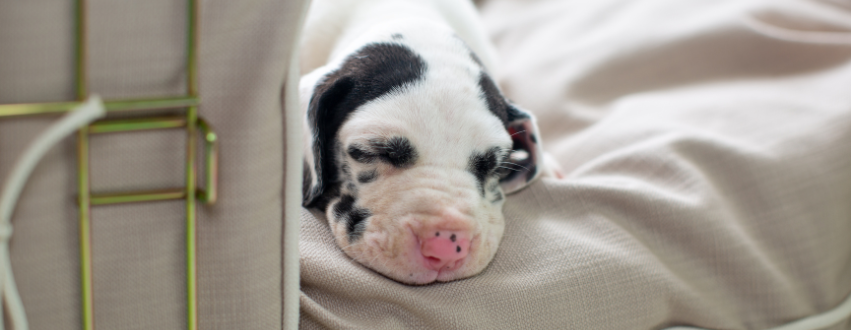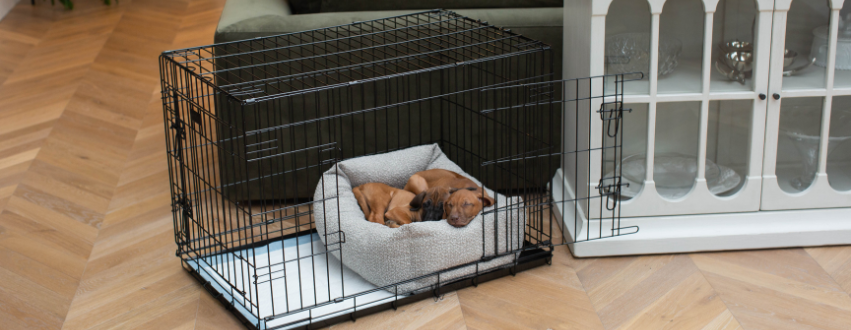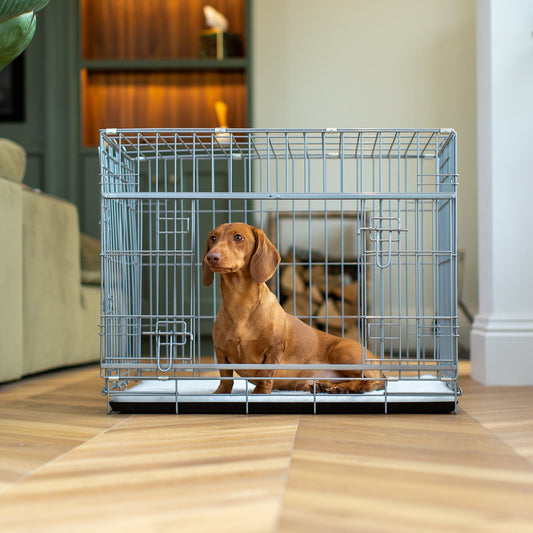We want nothing more than for our dogs to feel safe, comfortable and happy, and this is precisely what crate training is intended for. Dogs should view their crate as their haven and own personal den - a place they will voluntarily go to get some rest. You may be wondering how old you can start crate training, what the perfect puppy crate training schedule is, and if you can crate train an older dog. Our pet experts have put their top tips in this week's blog to help make your crate training journey as smooth as possible.
How Early Can You Start Crate Training A Puppy?

It is important to start as you mean to go on and introduce your puppy to their crate as soon as you bring them home, at about 8 weeks or so. Getting your puppy used to the crate early on helps settle them in to their new home quickly and efficiently; helping nervous puppies feel safe and also helping them with their toilet training.
We would suggest you have a crate set up ready for when you bring your puppy home. The crate should be big enough for them to grow into as an adult, but set-up slightly different whilst they are crate training.
How To Set Up A Cage For Crate Training
We recommend using one of our Cosy & Calming puppy crate beds, which are designed to fill around half the crate and then popping a piece of vet bed or some puppy pads down on the other half of the crate. This will divide your crate into two areas to help keep the crate cosy & comforting for your puppy. You could also use one of our crate covers to help block out any light and get your puppy in a routine with sleeping.
Benefits Of Crate Training A Puppy
- Gives them a safe space of their own which can help them stay calm in new or stressful situations, or when they're tired
- Can help to toilet train them
- A safe place for your dog or puppy to go when they're not being supervised
- It can make travelling with your dog easier as their safe space can come with you
- Can help with separation anxiety
How To Crate Train A Puppy
Slowly but surely is a great attitude to take when crate training your pup, never force them to go in but simply encourage them with treats and toys to go in.
We recommend keeping the crate door open in their area during the day so they can go in and out at will. You want the puppy to see the crate as their den; their escape from the rest of the household when they need a rest. It’s important not to lock them inside for long periods of time – the crate should never be used for punishment either. The longest they will be inside the crate is probably at night time.
You may wish to put the crate next to your bed, or just outside your bedroom at night time, so that they are near you and you can keep a close eye on them at intervals throughout the night.
If they fall asleep at any point in the day, you could pop them in their bed inside the crate, to help reassure them that the crate is a safe, comfortable space just for them. Young puppies will get used to the crate really quite quickly if they are introduced to it in the first few weeks of puppyhood.
By encouraging your pup to nap in their crate in the day it will make the transition to crate training them at night that little bit easier. We have a more indepth guide on how to crate train your puppy here, it has all of our pet experts top tips and tricks from crate training your puppy.
Puppy Crate Training Schedule

6am or as early as possible - Puppy will be very excited to see you and desperate for the toilet - take your puppy out first thing for a toilet break. Then provide playtime in and around the crate.
8am - After breakfast, take out another toilet break and walk. Then take back to the crate for a little play and a nap (door open)
9.30am -Toilet training, then another little play. Another toilet break and encourage a nap in the crate.
12pm - Lunchtime with a toilet break and a little play. Another toilet break if needed and then encourage a nap in the crate.
2pm - Toilet break and playtime. Another toilet break and encourage another nap in the crate (door open)
5pm - Toilet break after dinner.
6pm - Toilet break. Playtime in and around the crate.
How Long Does It Take To Crate Train A Puppy?
Some pups absolutely love their crate from day one, whereas for others it takes a little longer. Patience and reassurance are key in this process. Not all dogs learn at the same speed but with a little time, your puppy with learn to love their crate and view it as their own safe den!
Can I Crate Train An Older Dog?

Dogs definitely have the capability to be crate trained at an older age. Whether you’ve rescued an older dog or simply never got round to it when your dog was younger, you can still achieve the successful results of crate training. There are several benefits of going through this process with an older dog. These include:
- Creating a personal safe space for your dog
- Establishing a routine for them
- Making transportation easier and more convenient
- Creating a place they can go to calm down in situations they find to be uncomfortable or stressful.
It turns out that you can teach an old dog new tricks - it just requires time. Crate training an older dog is typically more difficult than crate training a puppy, as younger dogs don’t have formed routines that need to be broken. Older dogs, however, tend to be creatures of habit. Time needs to be taken for them to unlearn their old routine before going on to practise a new one.
How Do You Crate Train An Older Dog?
An older dog will soon appreciate the cosy interiors of their crate, more so than an excitable new pup. Place your crate in a quiet location so your dog has somewhere to escape for a daytime nap during louder times in your household. Follow the steps below on how to crate train your older dog.
- Prepare the crate - Choose a crate that’s big enough for your dog to stand up, lie down and move around in with ease. Pad it with blankets and, if applicable, their existing bed. Leave it in a busy location in the house and let your dog explore it naturally at first for a few days.
- Prepare yourself - If you have any negative preconceptions about crates, your dog will sense them and mirror your anxiety towards the crate. Begin training in a relaxed and positive manner.
- Prepare your pooch - It’s recommended that you should take your dog out for some exercise prior to training as a method of burning off some energy and make them more relaxed. A toilet break will also help to limit distractions and focus their concentration going into the training process.
- Create positive associations - Transforming a crate into a place where your dog feels happy is extremely important, so put treats and toys near the front of the crate. Every time your dog follows your command or goes in voluntarily to retrieve the items, be sure to give them lots of praise and positive reinforcement.
- Entice your dog inside the crate - Once your dog is comfortable going near the opening of the crate, move the toys and treats inside, along with their water and food bowls. If your dog is reluctant, place these items at the opening of the crate until your dog is comfortable sticking their head in. Then begin to slowly move them towards the back of the crate until your dog enters it completely.
- Close the door - Close the door when your dog enters the crate for a few seconds prior to opening it again. Repeat the process and keep the door closed for longer periods of time, as long as they remain comfortable.
- Increase time spent in the crate - Once your dog is happy being left in the crate with the door closed, leave it shut for a couple of minutes and gradually work this up to an hour before trying it for longer periods of time. Eventually, your dog will learn to like the crate and may even go in of their own accord.

































































































